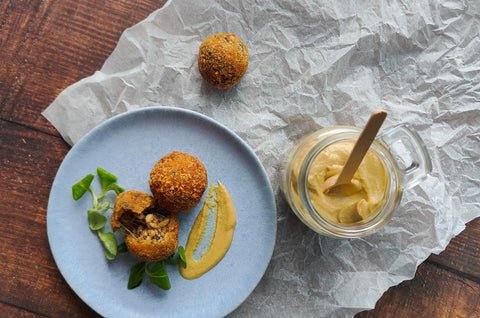As hot as mustard! A brief history of mustard in foods, from Ancient Egypt to modern America.
Mustard, a pungent spice derived from the seeds of the mustard plant, has been celebrated for its culinary and medicinal properties for millenia. Miles Phillips of Miles Marketing takes us on a culinary journey to explore the rich and diverse history of mustard.
The Ancient Origins of Mustard
The story of mustard begins in the ancient world, where it was first documented by civilisations such as the Sumerians and the Egyptians. Archaeological evidence suggests that mustard seeds were used by humans as early as 3000 BCE. The Greeks and Romans also recognised the value of mustard, not only as a culinary ingredient but for its health benefits. Hippocrates, the ancient Greek physician, used mustard in poultices to relieve muscle pain.
The first recorded use of mustard as a condiment is found in Roman texts. The Romans were known to grind mustard seeds into a paste, mixing them with wine or vinegar to create a sauce similar to the mustard we know today. A recipe from the Roman chef Apicius, dating back to the first century AD, includes mustard as an ingredient, highlighting its role in the cuisine of the time.
Mustard goes global
Mustard was not only a popular flavouring; it was also considered valuable. In medieval Europe, mustard seeds were traded like currency and were a symbol of prosperity and abundance. Monasteries became centres for mustard production, with Dijon in France emerging as a mustard-making hub by the 13th century. The city's ideal growing conditions for mustard plants contributed to its reputation as the mustard capital of the world.
As mustard made its way through Europe, it found new expressions in the hands of the French, English, and Germans. By the Middle Ages, mustard had become a staple of the European diet, with cities like Dijon and Meaux in France, Norwich and Tewkesbury in England, and Düsseldorf, Bautzen, and Bavaria in Germany becoming renowned centres of mustard production.
As hot as mustard!
‘As hot as mustard’ was the strapline used by prestigious catering company, Mustard Catering, in the 1970s. At the time, mustard was the spiciest condiment on the market, and Mustard was the hottest caterer in London. Led by legendary party planner Glynn Woodin, Mustard Catering revolutionised London’s high-end catering sector, facilitating numerous celebrity and royal events.
Today, Mustard Foods no longer caters to the stars, but continues the company legacy supplying the finest meals and sauces to the UK’s top hotels and restaurant groups.
The Many Shades of Mustard
American Yellow Mustard
Introduced in 1904 by George J. French as "cream salad mustard," American yellow mustard, with its bright yellow hue from turmeric, has become synonymous with hot dogs and baseball games. Its mild flavour, derived from yellow mustard seeds and a higher proportion of vinegar, has made it a favourite in the United States and beyond.
Deli-Style Spicy Brown Mustard
This variety, known for its coarsely ground brown mustard seeds, offers a spicier kick compared to its yellow counterpart. Often incorporating horseradish, spicy brown mustard, and particularly Creole mustard from Louisiana adds depth to sandwiches, meats, and sauces.
Dijon Mustard
Originating in 1856 from Jean Naigeon's innovation in Dijon, France, Dijon mustard replaced vinegar with verjuice, introducing a smoother, more sophisticated flavour. Mustard Foods incorporates dijon mustard in various traditional recipes including Beef Stroganoff and Steak Diane.
English Mustard
England's contribution, made famous by Mrs Clements in 1720 and later by Colman's of Norwich, offers a potent blend of yellow and brown seeds. It’s vibrant yellow colour and intense flavour make it a perfect complement to both hot and cold meats.
French Mustard
Despite its name, French mustard is a British invention by Colman's, characterised by its dark brown colour and sweet, tangy flavour. It became a beloved steak accompaniment until its production ceased in 2001 due to regulatory changes following Unilever's acquisition of Colman's.
Fruit Mustards
This tradition, dating back to the Lombards in the 14th century, combines fruit with mustard for a sweet and spicy condiment. Variants like apple mustard, quince mostarda, and cherry mustard serve as delicious accompaniments to meats and game.
Honey Mustard
A blend of mustard and honey, this sweet and tangy variant is a popular choice for sandwiches and as a dip, demonstrating mustard's versatility.
Hot Mustard
Employing pungent black or brown mustard seeds, hot mustard varieties like Karachi from Japan and those used in Chinese cuisine deliver a fiery heat, showcasing the spice's natural intensity.
Hot Pepper Mustard
By adding chilli peppers or hot sauces to mustard, this variant introduces an extra layer of heat, offering a spicier twist on traditional mustards.
Spirit Mustards
Incorporating alcoholic spirits, such as whisky or cognac, spirit mustards blend the rich flavours of alcohol with mustard's tanginess, creating a unique and sophisticated condiment.
Sweet Mustard
Popular in regions like Bavaria, sweet mustard combines sweetness with the traditional mustard flavour, providing a perfect pairing for dishes like Weißwurst.
Whole-Grain Mustard
Known for its rustic texture and robust flavour, whole-grain mustard mixes whole mustard seeds with various ingredients, offering a gourmet experience that enhances any dish.
Mustard Foods is a high quality food manufacturing business based in Wimbledon. Like the condiment it’s named after, Mustard has a strong reputation in the foodservice industry, supplying ready-to-serve meals, sides, and sauces to London’s top restaurants, 5-star hotels, and corporate offices. Contact us for more information and request samples.





Comments (0)
There are no comments for this article. Be the first one to leave a message!